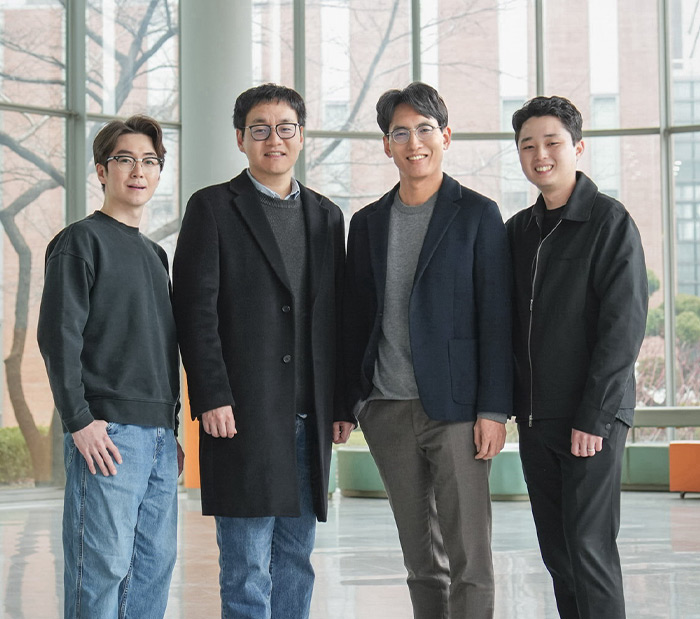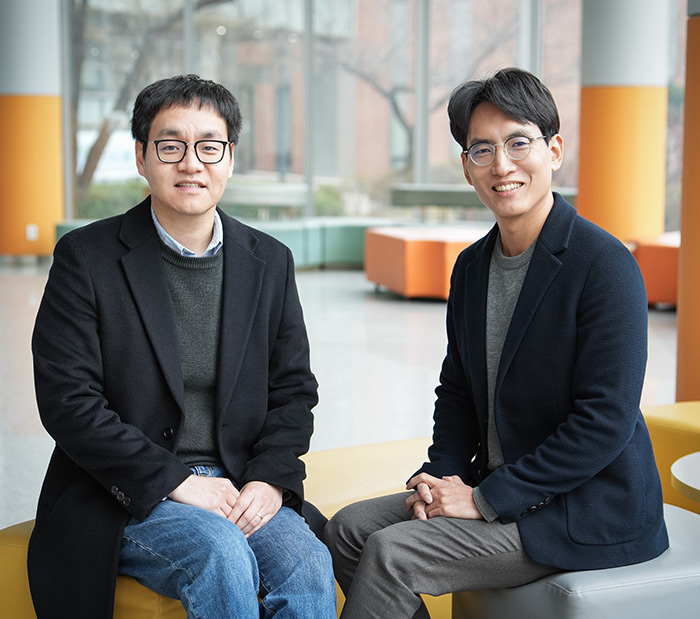Development of two novel methodologies for efficient representation of complex 3D scenes
전자전기/인공지능학과 박은병, 고종환 Prof. · Prof. Eunbyung Park and Prof. Jong Hwan Ko
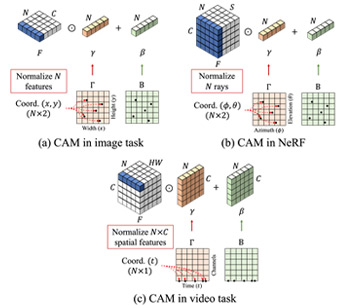
-
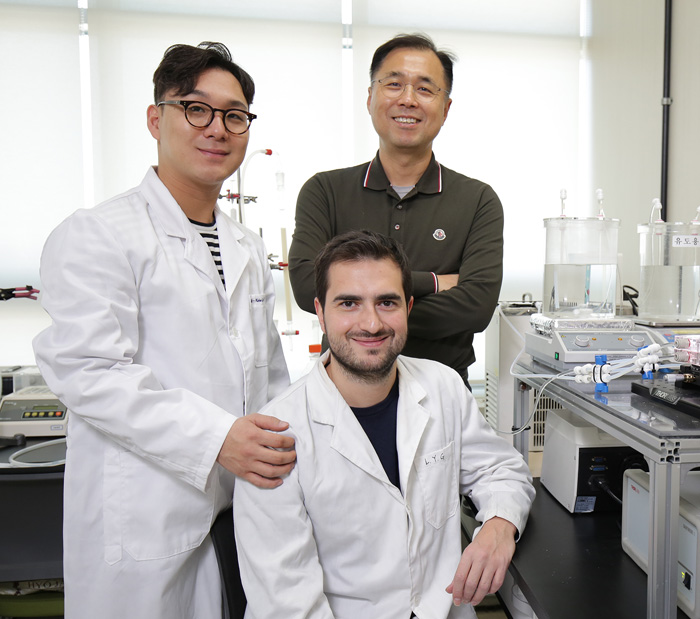
Graduate School of Water Resources JANG, AM Prof.
Development of Energy-saving Volume Retarded Osmosis(VRO) - Low Pressure Membrane(LPM) Hybrid System
Development of energy-saving volume retarded osmosis (VRO)-low pressure membrane (LPM) hybrid system for water treatment and identification of initial fouling mechanism in forward osmosis water treatment process. Dr. Am JANG, a Professor from the College of Construction and Environmental System Engineering and Graduate School of Water Resources, and his research team have developed volume retarded osmosis (VRO)-low pressure membrane (LPM) hybrid system. The discovery of such novel process has lead to a publication of a paper in "Scientific Report (Impact factor=4.259, upper 16% of JCR journal in multidisciplinary sciences field)", a journal from the publishers of Nature, on November 6th, 2017 (online). Additionally, they have identified the initial organic fouling phenomenon that could occur in spiral-wound forward osmosis process at semi-pilot scale, with the use of real wastewater and the membrane surface analysis method. This lead to a publication in "Chemical engineering journal (primary author: Sung-Ju Im, phD student) (Impact factor = 6.216, upper 4.5% of JCR journals in chemical engineering field)", one of the most powerful and effective journals around the world, on November 2, 2017. Forward Osmosis (FO) technology is a water treatment technology based on the osmotic pressure gradient of both solutions (feed and draw). It has been actively studied in academia and industry, and is considered as a substitute for reverse osmosis-based seawater desalination technology and a next-generation desalination technology. In general, since the forward osmosis technology requires a post-treatment technique for separating the draw solute from a high concentration of the draw solution, many researches and attempts have been made to develop an appropriate post-treatment technique. However, the high operating pressure (energy) of the post-treatment technology is pointed out as a limitation of the forward osmosis technology, and the development of a forward osmosis process that does not require post treatment, or post treatment with low or no energy requirement is urgently needed. Through this research, Professor JANG and his research team, was the first to devise and develope a water treatment system design that can utilize the pressure to be used as the driving force for the low pressure membrane, via increase of draw solution volume in a closed tank. The value of this study is unmeasureably high, seeing as how the limitation of the existing osmosis process was improved, the possibility of practical use of the osmosis process was increased, and the direction of the new osmosis technology was suggested through this study. In addition, the spiral-would forward osmosis element is the most common form of the conventional element types, and it is similar to the reverse osmosis module that is used for seawater desalination. To date, the identification of the fouling phenomena of forward osmosis membranes has been limited to laboratory scale (Lab-scale) or to identifying them using model foulants. However, there are limitations in terms of operating conditions and structural characteristics of elements in order to apply the results to the actual process (element scale or pilot scale). Professor JANG’s research team determined the initial fouling mechanism, when spiral-wound forward osmosis element was used with wastewater as feed solution. The results of this study is very valuable, for it can help comprehensively understand the fouling mechanism of the forward osmosis, allow prediction of overall fouling phenomena in actual process, and help understand overall development of forward osmosis process. Professor Am JANG, who conducted and led the study, said, "The results of this study have a great significance in overcoming the limitation of the forward osmosis process, a next generation water treatment technology. Not only it is significant, but the results from this study is also valuable, since understanding of the fouling phenomena is the key factor in development of forward osmosis technology. " Based on the results of this study, Im Sung-Ju, a phD student and the first author of the published paper, presented at the International Desalination Workshop 2017, and was awarded by the Minister of Land, Transport and Tourism. This study was carried out through researches on forward osmosis-reverse osmosis hybrid system, which is supported by Korea Agency for Infrastructure Technology Advancement, and through monitoring of irreversible foulants in the osmosis - based membrane process, supported by the research project of the Korea Research Foundation. Titles of the published papers: - New concept of pump-less forward osmosis (FO) and low-pressure membrane (LPM) process - Organic fouling characterization of a CTA-based spiral-wound forward osmosis (SWFO) membrane used in wastewater reuse and seawater desalination
- No. 67
- 2018-07-05
- 1873
-
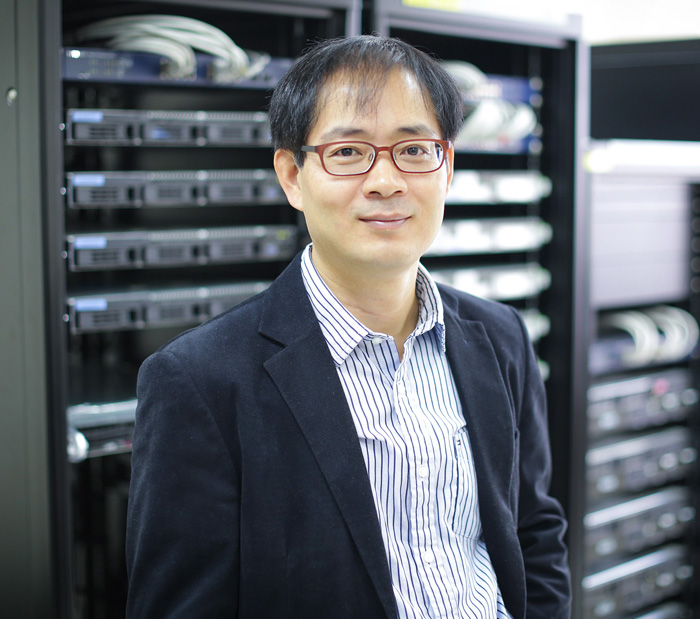
Chemistry LEE, JINYONG Prof.
Investigation for changes of band alignment according to size of titanium dioxide nanoparticles
A research collaboration team led by Prof. Jin Yong LEE (Dept. of Chemistry) and Prof. Francesc ILLAS (Barcelona Univ. in Spain) theoretically investigated the changes of band alignment according to size of titanium dioxide nanoparticles using quantum calculations. This research was published in the Journal of the Physical Chemistry Letters (IF: 9.353, JCR top 1.4 %) as of 16th November, with the title “Size-Dependent Level Alignment between Rutile and Anatase TiO2 Nanoparticles: Implications for Photocatalysis”. Titanium dioxide is definitely the most popular resource for the photocatalytic materials on the fields of academia as well as industry. They have commonly used a mixture of nanoparticles of anatase and rutile polymorphs to increase photocatalytic activity. Up to now, various experiments have been conducted to demonstrate the type of band alignment between two polymorphs. However, there are many difficulties to guarantee the same experimental condition and uniformity of titanium dioxide samples in each experiment. For this reason, several different types of band alignment have been reported from many experiments. Still many arguments about the type of band alignment have not came to an agreement yet. Prof. Lee group theoretically investigated the changes of band alignment according to the size of titanium dioxide nanoparticles based on quantum calculations for the first time. This work will be very useful to make researchers comprehensively understand the photocatalytic activities of various experiments handling titanium dioxide nanoparticles. Prof. LEE said, “Our theoretical prediction properly explains the type of band alignment for Degussa P25 which is composed of anatase and rutile titanium dioxide nanoparticles and has been commercially and most widely used, and our results on the nanoparticle size effect would provide invaluable information to explain the photocatalytic activity changes between different titanium dioxide samples in real experiments.” This research was supported by the National Research Foundation of Korea (NFR) and Korea Institute of Science and Technology Information (KISTI) supercomputing center.
- No. 66
- 2018-07-05
- 1807
-
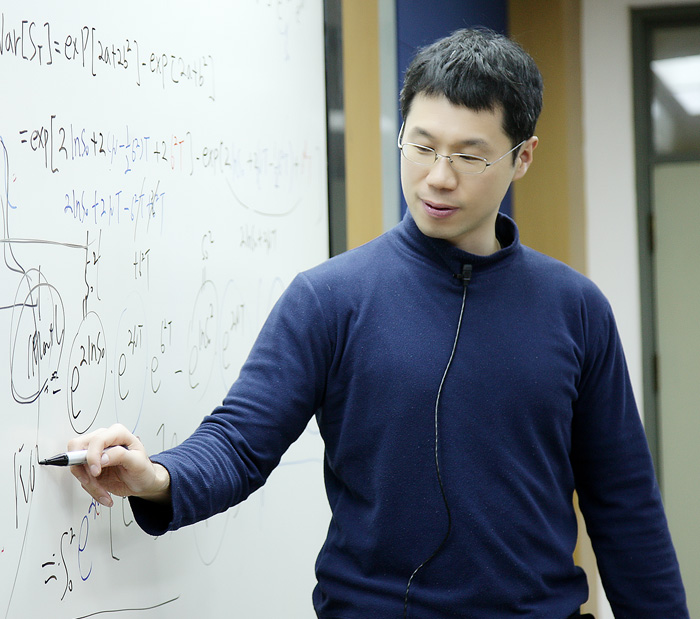
Economics RYU, DOOJIN Prof.
Prof. Doojin RYU Suggests a New Framework of Microstructure Studies and Extends Classical Models
Studies in financial market microstructure examine the intraday price, volume, spread, and volatility dynamics of financial markets and illuminate how the latent demands of market participants are translated into intraday price and trading behaviors. The field of financial market microstructure studies has evolved since the early 90’s. The primitive microstructure models have very simple structures and the earlier microstructure theories do not adequately exploit the rich information provided by the big data of financial markets. Professor Doojin RYU suggests a new framework of microstructure studies and extends classical models in order to reflect various characteristics of intraday transactions and to derive meaningful economic implications. His first microstructure research provides an extended model to answer the question of who has an information edge in a highly fluid options market. It was published in the Journal of Futures Markets, a reputable finance journal, oriented to derivatives markets (“Informed trading in the index option market: The case of KOSPI 200 options,” Journal of Futures Markets, 2008, 28:12, 1118-1146). After the study, he suggests a cross-market microstructure model, which is new in this field. While existing studies only concentrate on the intraday asset price dynamics in a single market, his new approach considers the order and information flows from related asset markets when inferring the intraday dynamics of a main financial market (“Intraday price formation and bid-ask spread components: A new approach using a cross-market model,” Journal of Futures Markets, 2011, 31:12, 1142-1169). Recently, Prof. RYU has suggested comprehensive microstructure models to capture all aspects of microstructure information. The studies are “Considering all microstructure effects: The extension of a trade indicator model, Economics Letters, 2016, 146, 107-110” and “Trade duration, informed trading, and option moneyness, International Review of Economics and Finance, 2016, 44, 395-411”. He also analyzes how the violations of intraday option price monotonicity are related to investor characteristics and other microstructure noises. This study was recently published in the Journal of Futures Markets (“Option market characteristics and price monotonicity violations,” Journal of Futures Markets, 2017, 37:5, 473-498). By analyzing the high-frequency and high-quality information contained in the microstructure dataset of the Korean derivatives markets, he estimates his extended models and suggests important policy and regulatory implications.
- No. 65
- 2018-07-05
- 2920
-
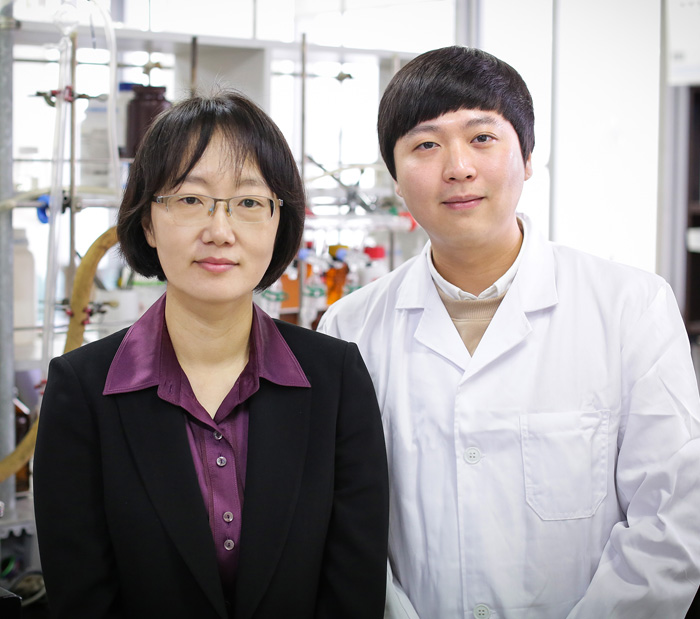
Chemistry YUN, JAESOOK Prof.
Prof. Jaesook YUN developed Asymmetric Hydroboration of 1,1-Disubstituted Alkenes by Copper Catalysi
A research team led by Prof. Jaesook YUN (Dept. of Chemistry) developed the asymmetric hydroboration of 1,1-disubstituted alkenes by copper catalysis. This research was published in the Journal of the American Chemical Society (IF: 13.858) as of 4th October, with the title "Copper-Catalyzed Enantioselective Hydroboration of Unactivated 1,1-Disubstituted Alkenes." This work presents the first highly enantioselective hydroboration of 1,1-dialkylsubstituted alkenes, which has not been solved for last 60 years since the Nobel Laureate H. C. BROWN reported the first asymmetric hydroboration. The method allows facile preparation of enantiomerically-enriched chiral alkyl boron compounds from 1,1-disubstituted alkenes. This work has provided several important clues that could truly be a big step in this research field. Prof. YUN said, "Our strategy will provide a useful synthetic tool for drug or natural product synthesis." This work has been recently selected for the Highlights of Organic Process Research & Development (IF: 2.857) by a group of industrial chemists who evaluated the work as a versatile and practical solution that should find many uses. The highlight will be published in November, 2017. This research was supported by the National Research Foundation of Korea (NRF) and the Basic Research Laboratory (BRL) Program.
- No. 64
- 2018-07-05
- 3363
-
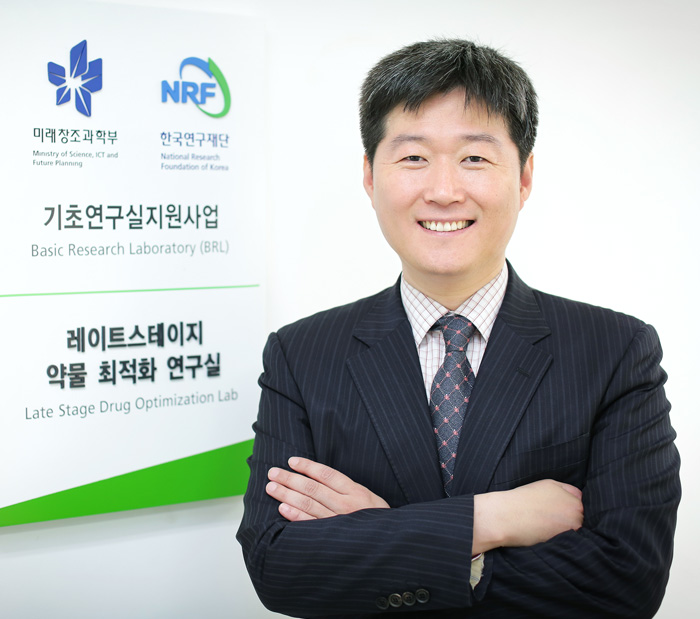
Pharmacy KIM, IN SU Prof.
Development of Next-generation Anticancer Substance beyond Conventional Anticancer Drugs
Very recently, the research group of Professor In Su KIM, School of Pharmacy at Sungkyunkwan University has published a nice work on the October issue of 'Advanced Synthesis & Catalysis' (IF 6.453, JCR ranking 1.4%, in applied chemistry) and highlighted as a cover picture. Professor In Su KIM’s group has developed a Rh(III)-catalyzed novel synthetic method for 7-azaindole compounds, which known as a key unit structure of drug molecules. In particular, by introducing a selective and efficient amination reaction of carbon-hydrogen bond, they have developed a new effective substance which shows stronger anticancer effect than existing anticancer drugs. Professor In Su KIM is pursuing research to maximize the efficiency of new drug development under the theme of 'Late-Stage Drug Optimization laboratory'. In particular, it has been studying to produce new drug candidates that have anti-cancer, anti-diabetic and antimicrobial effects. The results of the study showed that the unit structure containing an amine group was introduced into an azaindole compounds, found in a variety of pharmaceutical molecules. Synthetic compounds have been shown to have superior anticancer activity than doxorubicin as a well-known anticancer drug. Professor In Su KIM said, "As a new technology that is different from conventional methods, it is a new way to drastically improve the synthesis process of pharmaceuticals, especially anticancer drugs" and “as part of the development of new anticancer drugs, we plan to develop new anticancer drug molecules through our synthetic methodology. " This research was carried out with the support of the Basic Research Support Program (BRL) initiated by the Ministry of Science, ICT and Future Planning (Minister, Young Min YOU) and the National Research Foundation of Korea (President, Moo Je CHO).
- No. 63
- 2018-07-05
- 1685
-
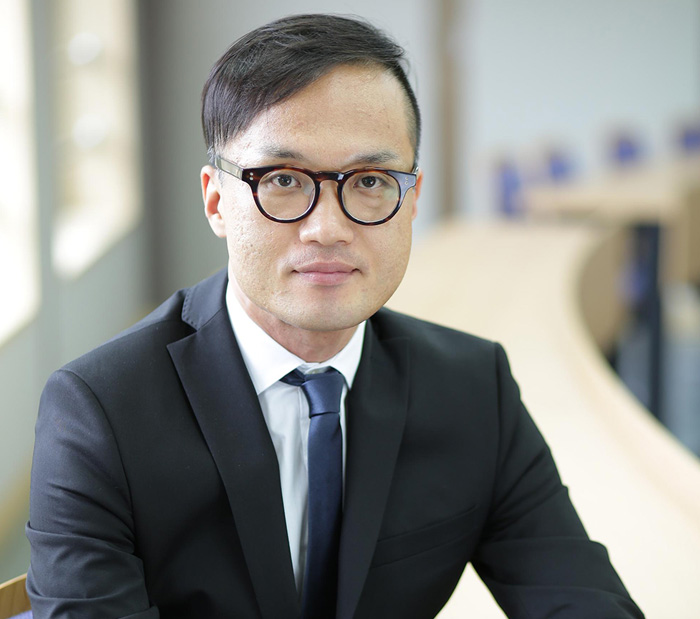
Chemical Engineering UM, SOONG HO Prof.
Prof. Soong Ho UM Discriminates a Tumor Heterogeneity Using a Fluorescence-encoded DNA Nanostructur
A tumor is a devastating disease, and it is important to apply appropriate therapeutic and diagnostic tools to accurately detect the cancer stage and type. Early detection of cancer is associated with a higher percentage of recovery after treatment, and it is more important to identify the molecular signature of cancer as early as possible. Micro-RNA, which is abbreviated miR or miRNA, has recently been known as a potential tumor-associated signature that can indicate early cancer development. In addition, because miRNAs regulate transcription of mRNA in the upper level of the cascade, a miRNA network significantly influences cellular metabolism, development, differentiation, establishment, and even stress response. miRNA profiles provide essential clues about metabolic heterology in tumorigenesis. Types and mechanisms of cancer-specific miRNAs can be identified for clinical index. Quantification of multiple miRNAs in a living cell leads to better understanding of cancer. Significant correlation of specific miRNA variances that exist during progression from primary tumor to metastasis can be used to predict the effective diagnosis of whole-stage cancer. Moreover, in addition to a change of tumor concept, in which there is a successive process of clonal evolution at the tumor site, cell-to-cell variation and interfacial communication should be detected for personalized medicine. Several nanotechnology-based systems were developed for miRNA detection at the cellular level. However, quantitative analysis of multiplex miRNAs in a living cell is difficult due to the cellular transport kinetics of each cell type. To date, Prof. Soong Ho UM and Dr. Seung Won SHIN present a novel miRNA detection platform using fluorescence-encoded nanostructured Prof. Soong Ho UM Discriminates a Tumor Heterogeneity Using a Fluorescence-encoded DNA Nanostructur DNA probing for quantitative analysis of multiplexed miRNAs in living cells. His research group has been working for over a decade to design novel molecular diagnostic tool kits based on DNA nanotechnology for biomedical purposes. Nanotechnology-engineered platforms as synthesized can provide highly programmable and predictable labeling of various miRNAs specific to the type of cancer in a technically simple manner at the molecular scale. In this study, Prof. UM and his colleagues demonstrate that it is eventually possible to encode fluorescence colors of cancer-specific miRNA signatures in cells using new DNA nanotechnology and to track the presence of fluorescent cells in in situ. Prof. UM speculates that this novel nanostructured DNA-based diagnosis can provide not only important information for tumorigenesis, but can also be applied in personalized medicine as an easy-to-use tool kit. This demonstration of efficient cancer cell labeling and its in situ cancer-staged tracking and tumor heterogeneity, which may be not easy to be realized without this new scientific tool kit, will be of great interest to anyone who is seeking for a new scientific report for progressive technology developments at a cutting-edge cancer diagnosis. This work was supported by a grant from both the Korea Health Technology R&D Project through the Korea Health Industry Development Institute (KHIDI) funded by the Ministry of Health & Welfare and the Basic Science Research Programs through the National Research Foundation of Korea (NRF) funded by the Ministry of Science, ICT, and Future Planning, Republic of Korea.
- No. 62
- 2018-07-05
- 2312
-
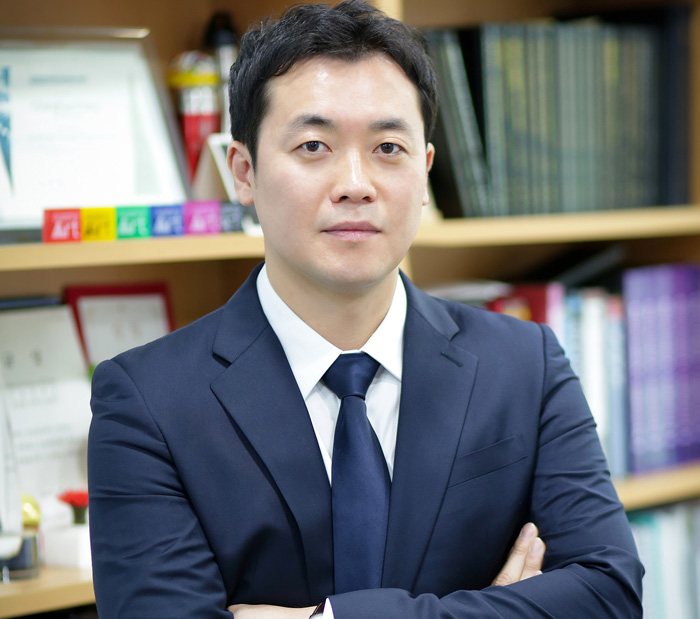
Chemical Engineering PANG, CHANGHYUN Prof.
Development of Ultrafast H2 Sensors that Requires No Additional Electrical Apparatus
By imitating the antennae of insects, ultrafast H2 sensors that requires no additional electrical apparatus was developed. The new sensors that realizes high hydrogen detection performance and safety simultaneously can be widely applied from precise measuring equipment to simple leak alarms, so it is expected to have a great ripple effect across the industry and households in the future. Hydrogen is used as an essential material in many industries such as petroleum, chemical, and steel, and its usage is increasing every year in everyday life. However, the use of a hydrogen leak detection system is essential because it can explode easily even when the concentration exceeds only 4% in the air. An existing commercialized hydrogen sensors such as electrochemical sensor, catalytic sensor, acoustic sensor, ceramic sensor and semiconductor sensor require additional apparatus such as display and speaker. These also requires a power supply for hydrogen detection, which increases the risk of explosion when hydrogen is leaked. In order to overcome these limitations, sensors that use optical signals instead of electrical signals and make it possible to detect the leakage of hydrogen visually have been developed. However, because these are usually based on chemical reactions between hydrogen and reactive materials, response time is slow. In addition, since these have irreversible characteristics at room temperature, the possibility of actual commercialization is very low. In order to develop a hydrogen sensor with high sensitivity and high response rate without the need for power, the researchers developed a nano/microactuators that changes its shape in response to hydrogen by imitating the antenna structure of insects. This nano/microactuators is made by coating palladium on the flexible polymer asymmetrically, and hydrogen gas stimulation can be detected with visually without additional display and power supply by maximizing the changes in the optical characteristics of the dev ice due to changes in the shape of the nano/microactuators by hydrogen. Furthermore, the researchers developed a new type of hydrogen sensors such as wetting-controllable H2-selective smart surfaces, a hydrogen sensitive locking device capable of controlling adhesion by hydrogen. The results of this research can be applied not only to existing industries such as petroleum, chemical, steel, but also to everyday life such as hydrogen stations, hydrogen vehicles, and fuel cell distributed generation systems. Especially, because of its distinguishable advantage such as non-power source, non-explosive, ultrasensitive, its high demand is expected with the explosive growth of the hydrogen fuel cell market. Also the factor that it is produced at low cost compared with existing hydrogen sensors although it requires no additional electrical apparatus and makes it possible to detect a hydrogen the naked eye is competitiveness both at home and abroad.
- No. 61
- 2018-07-05
- 1745
-
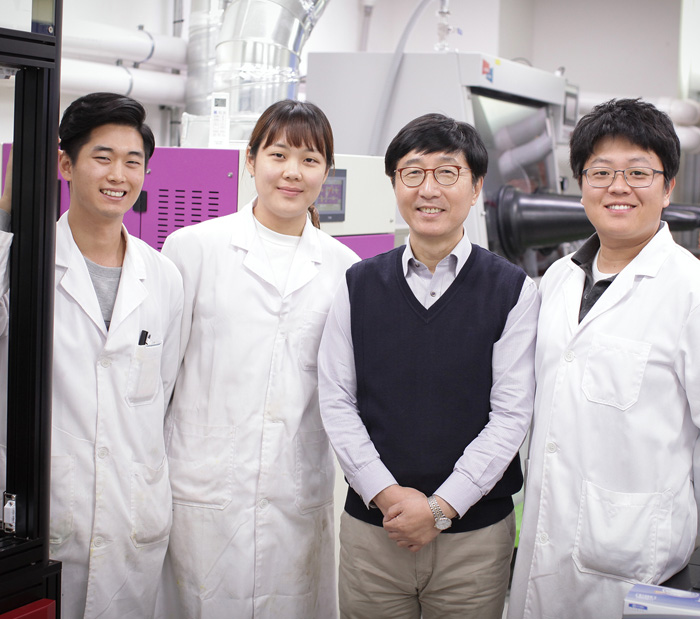
Chemical Engineering PARK, NAM-GYU Prof.
Development of X-ray Material with Almost No Radiation Using Microcrystalline Halide Perovskites
A collaborative research project with Samsung Electronics A semiconductor material that can reduce the amount of radiation exposure while taking medical X-ray images to less than 1/10 has been developed. On the 11th, it was announced that an ‘X-ray detector’ that can increase sensitivity by over 20 times more than conventional flat X-rays by using perovskites semiconductor material was developed. An X-ray detector is a kind of image sensor that absorbs X-rays. The new material developed by the research team has high sensitivity, so it is possible to obtain a clear medical image while reducing the radiation dose. The cost of production is also low. Unlike conventional detectors, which are made by vacuum processing used in semiconductor manufacturing, the new detector can be made through a liquid process, so a large screen can be made. If this technology is commercialized, it will be possible to make X-ray devices that can take an image of the whole body at once. Perovskite has excellent characteristics of converting light into an electric current, so it is a material that is very popular in the fields of solar cells and X-rays. X-ray devices are widely used for medical purposes because they can convert X-rays transmitted through the human body into pictures and images, but they are expensive and result in large doses of radiation. For this reason, research and development projects to reduce X-ray exposure are being widely carried out in the United States, European Union, etc. The research team expects that X-ray devices that can dramatically reduce X-ray exposure will be developed in a few years. If the remaining technical problems are improved, X-ray medical imaging technology that reduces the radiation dose to less than 1/10 is expected to be available in the practical field of medicine. The results of this research have been published in the online edition of the worldwide scientific journal Nature, titled "Printable organometallic perovskite enables large-area, low-dose X-ray imaging."
- No. 60
- 2018-07-05
- 1863
-
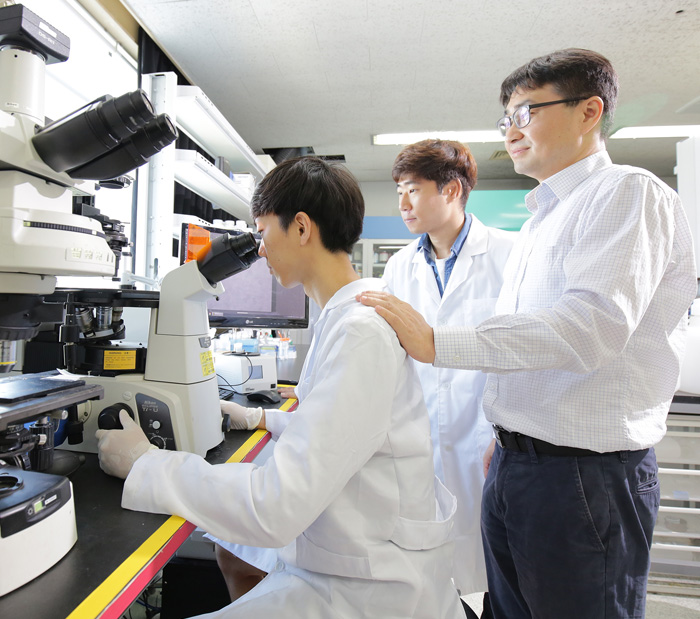
Chemical Engineering YI, GI RA Prof.
Prof. Gi Ra YI Develops New Method for Mass Production of Patchy Particles
□ Associate Professor Gi-Ra YI in School of Chemical Engineering, Sungkyunkwan University and Assistant Professor Stefano SACANNA at chemistry department of New York University developed together new method for mass production of patchy particles which can be assembled as do molecules. □ Researchers began with a set of four large solid polystyrene spheres arranged in a tetrahedral manner around a smaller, softer silicone oil droplet. These two components are oppositely charged and thus spontaneously assemble into clusters. They then add a plasticiser (terahydrofuran), which allows the polystyrene spheres to flow and reconfigure into a single, bigger sphere thanks to surface tension. This process can be likened to the way balls of playdough can be squashed together. As the outer spheres fuse together to form a single sphere, the inner silicone oil droplet in fact deforms to fill the spaces inside the sphere. It is eventually pushed out to form a tetrahedral pattern of patches on the sphere’s surface. These patchy spherical-shaped particles are produced in over 90% yield. □ Adding patches to self-assembling systems in this way could allow us to produce colloidal nanostructures. Until now, however, it was not easy to yield enough particles to make a material big enough to hold in their hands. □ On the other hand, at low pH, oil droplets surrounded with four spheres can be stayed in the center during deformation by adding plasicitizer, in which oil droplets are first faceted into tetrahedra and then become spheres. Researchers can polymerized in the middle of deformation which produced uniform tetraheron particles. □ The research is detailed in Nature doi:10.1038/nature23901. □ “Mass production of patchy particles has been one of most important problem in fabricating nanostructured materials by self-assembly” says Prof. Gi-Ra Yi. This will be used now for builidng up new colloidal structures which may be used for even 3D printers with complex internal nanostructures.
- No. 59
- 2018-07-05
- 2190
-
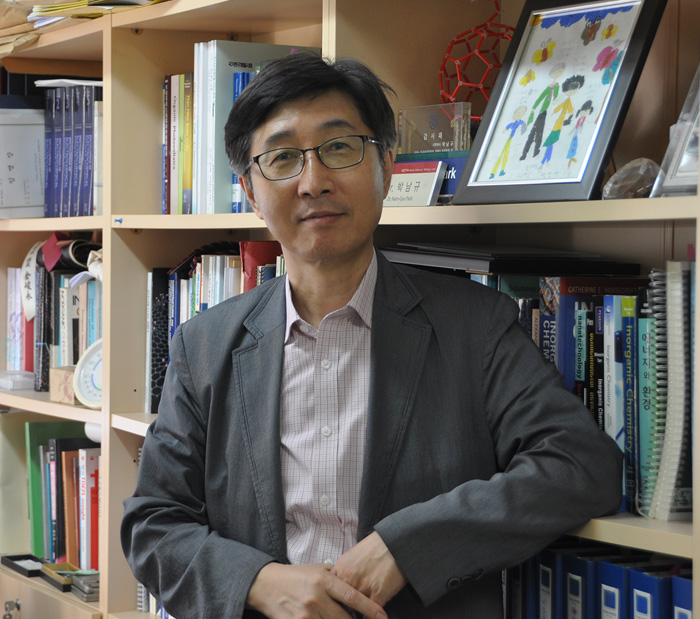
Chemical Engineering PARK, NAM-GYU Prof.
Next Generation Perovskite Solar Cell with Improved the Efficiency and Stability
Solar energy is an expected source of energy that can play an important role in energy supply in the future of the world. As part of the response to changes in the environment due to global climate change, there is an ongoing effort to increase the proportion of power generation from renewable energy. It is expected that solar cells will take the largest proportion in such a flow. Recently, researchers have focused on organic-inorganic composite material having a perovskite structure that would allow low-cost and high-efficiency solar cell as a new photo-active material. Perovskite solar cells, one of the ten scientific breakthroughs in 2013, are in close proximity to the efficiency of crystalline silicon (~ 25 %) solar cells by the rapid improvement of the efficiency (from 2.2 % in 2008 to 22% in 2016). It, as next-generation solar cell with superior performance in low-cost materials that are based on cheap solution process, are expected to be able to replace the conventional silicon solar cells. Perovskites are materials described by the formula ABX3, where X is an anion and A and B are cations of different sizes (A being larger than B). Perovskite which is used for solar cells has methylammonium in the A site, B site is lead or tin ion, and X site is composed of halide ions. It simply shows the following attractive properties as a photo-active materials; a bandgap of around 1.6 eV, high extinction coefficient, with long electron-hole diffusion length (0.1 ~ 1mm). The most successful architecture of the perovskite solar cells has adopted the titanium oxide and the Spiro-OMeTAD(2,2′,7,7′-tetrakis(N,N′-di-p-methoxyphenylamine)-9,9′-spirobifluorene) as charge transfer layer. Despite the high efficiency, however, the current - voltage hysteresis (asymmetry result in current-voltage measurement between forward and revers scan) has dropped reliability of the device. Meanwhile, perovskite solar cells using PEDOT: PSS (poly (3,4-ethylenedioxythiophene) poly (styrene sulfonate)) and PCBM (phenyl C61 butyric acid methyl ester) also can be manufactured. Current-voltage hysteresis that reduces the reliability of the solar cells was significantly suppressed when producing a solar cell in this structure. Another problem of the perovskite solar cells is low stability. This material is highly vulnerable to moisture and heat. The efficiency of the solar cell can be rapidly decreased within a few hours to exposure in the air. Therefore, it is an important issue for practical use to improve the stability of the perovskite solar cells. The researchers reported highly efficient perovskite solar cell based on chemically stable Nickel Oxide (NiO) with 16.40 % of power conversion efficiency by replacing PEDOT:PSS, organic charge transporting material. Although PEDOT:PSS has superior functionality to extract charges selectively from the perovskite layer, PEDOT:PSS promotes the decomposition of the perovskite which is moisture-sensitive due to its hygroscopic nature. On the other hand, nickel oxide, can improve the stability of the perovskite solar cells by retaining the chemical stability. Perovskite solar cells based on NiO, however, have suffered from relatively lower performance with smaller fill factor and photocurrent density compared to devices based on PEDOT:PSS. The researchers prepared the ultrathin NiO films (a few nanometers in thickness) deposited by atomic layer deposition (ALD) method for highly efficient perovskite solar cells. The Ultrathin Nickel Oxide showed an improved hole transport property compared to the bulk Nickel Oxide films. In addition to this, high transparency of such a thin nickel oxide helps the perovskite to exhibit the high power conversion efficiency. Further, the solar cell has maintained 90% of the initial efficiency over 500 hours when stored under inert gas atmosphere. The result is expected to be the basis for the development of highly efficient and reliable perovskite solar cell for future commercialization. The research was published in ‘Nanoscale’.
- No. 58
- 2018-07-05
- 1754
-
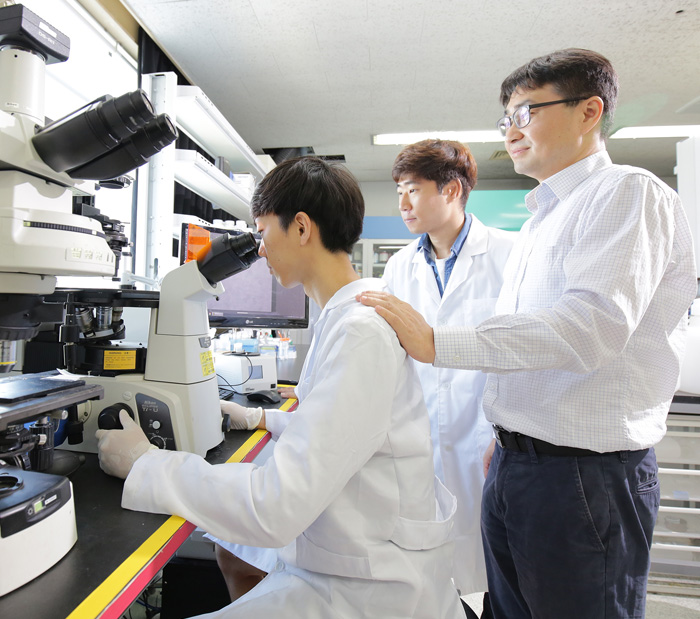
Chemical Engineering YI, GI RA Prof.
Profs. Gi-Ra YI & Jaeyun KIM's Study on Vanishing Colloidal Mesoporous Nanoparticles to Heal Wounds
The research team under Profs. Gi-Ra YI and Jaeyun KIM at Sungkyunkwan University's Department of Chemical Engineering have developed a colloidal mesporous nanoparticle solution that has the potential to rapidly and and effectively close wounds in the skin when it spreads, then degrades away after the wound heals. Figure 1. Schematic illustration of wound healing process on mouse skin by applying mesoporous nanoparticles The fundamental research behind the rapid wound closure is the high surface area of the colloidal mesoporous silica nanoparticles in which extracellular matrixes within biological tissues are strongly absorbed on the surface of the nanoparticles; therefore, the wound is rapidly closed. By introducing the mesopores and controlling the average diameters on the surface, the research team has shown increases of up to 10 times more adhesion energy compared to nonporous silica nanoparticles, even at 10 times lower concentration. Figure 2. Graphical illustration of extracellular matrixes interacting on the surface of mesoporous nanoparticles The team has also compared the use of colloidal mesoporous silica nanoparticles with conventional suturing and chemically treating agents in wound closure. The result confirmed that the colloidal mesoporous silica nanoparticles are much more convenient to use, the adhesion was stronger, and most importantly, there were no signs of inflammation or scars. Figure 3. In vivo comparison of wound healing on mice by methods and time Once the wound is closed and healed, the colloidal mesoporous silica nanoparticles degrade easily in biological media. The fact that colloidal silica nanoparticles degrade is advantageous, confirming the possibility of being used as biocompatible adhesive material. The research was supported by the Engineering Research Center and the Bank of Porous Nanoparticles from the National Research Foundation (NRF) of Korea, and was published in the journal ACS Applied Materials and Interfaces (Impact Factor 7.504) on August 24th, 2017. Title: Colloidal Mesoporous Silica Nanoparticles as Strong Adhesives for Hydrogels and Biological Tissues Authors: Joo-Hyung KIM (Research Assistant), Hodae KIM (M.S.), Youngjin CHOI (Ph.D), Doo Sung LEE (Professor), Jaeyun KIM (Associate Professor), and Gi-Ra YI (Associate Professor) The research team is currently continuing this study to combine wound healing agents for colloidal mesoporous silica nanoparticles capable of dual rapid closure/healing treatments.
- No. 57
- 2018-07-05
- 2154
-
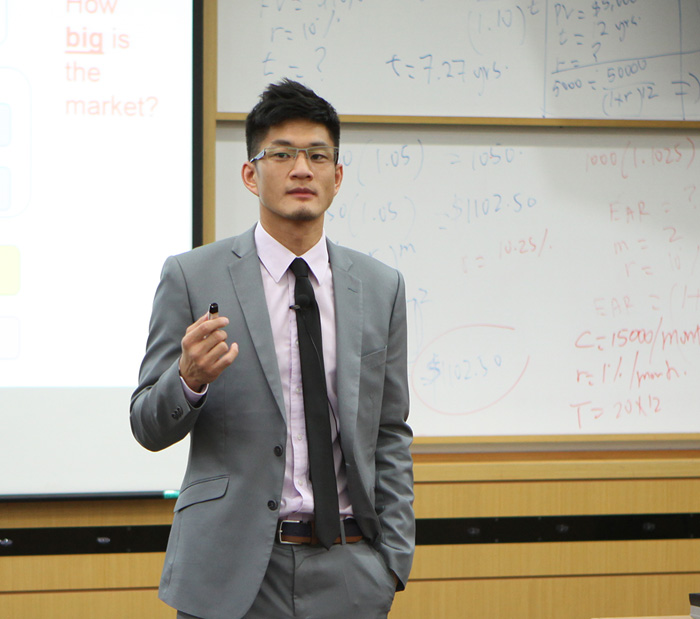
TSE, CALEB Prof.
A Multimediation Model of Learning by Exporting: Analysis of Export-Induced Productivity Gains
Learning-by-exporting describes the phenomenon that firms can learn as a result of engaging in exporting to other countries, and this learning helps the exporting firms to become more productive. The phenomenon has been studied in different contexts by international business, economics, and strategic management scholars. Some scholars have found empirical evidence in support of it, while others have not. As global markets continue to rise in competitiveness, a more complete understanding of learning-by-exporting will provide useful knowledge to researchers, firm managers, and policy makers. In a recently published article, Professor Caleb H. TSE, along with his co-authors, argue that previous studies only sought to uncover whether the learning-by-exporting effect exists or not, and have overlooked the exact mechanisms that may cause the learning-by-exporting effect. The team created a theoretical model that examines the mediating mechanisms of the learning-by-exporting effect, and theorized that by exporting, firms acquire knowledge, learn and become more productive through the specific mechanisms of innovativeness, production capability improvements, as well as improvements in human capital. Using data from 250,000 Chinese firms over a 7-year period (2001-2007), the team found strong empirical evidence not only for the learning-by-exporting effect, but also for these mediating mechanisms. They also uncovered various boundary conditions to the learning-by-exporting effect. Non-state-owned enterprises and firms in industries with a moderate level of export intensity, as well as firms in industries with a medium to high level of new product development intensity, are able to effectuate more learning through these mechanisms than their counterparts. The study sheds light on the specific knowledge benefits that firms can gain from exporting which lead to increases in productivity. It also points out how policy makers can promote environments that encourage firms and industries to capitalize on this learning-by-exporting effect.
- No. 56
- 2018-07-05
- 3039
